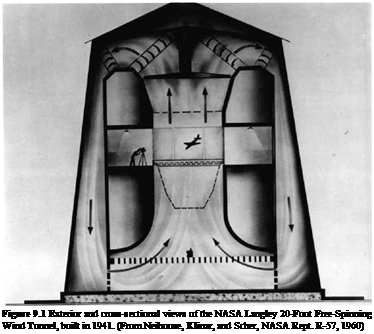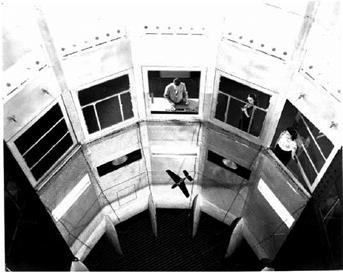Advent of the Free-Spinning Wind Tunnels
NACA research on airplane spinning began about the year 1926 (Zimmerman, 1936). At first, dynamically scaled airplane models were launched from the top of a balloon shed and observed as they fell. Hartley A. Soule and N. A. Scudder are associated with these early tests. Similar work went on in Britain at that time. A. V Stephens writes (1966):
The technique of using balsa wood [drop] models for spinning research had originated in America and had promptly been abandoned. It was taken up at the Royal Aircraft Establishment [RAE] by K. V Wright and the author, who launched the models from the catwalk
|
|

in the roof of the balloon shed and observed their fall. Just as the technique was beginning to yield useful results it was decided to demolish the balloon shed. At this point R. McKinnon Wood put forward a characteristically original suggestion that such experiments could be done in a large vertical wind tunnel. Pessimists argued that the models would immediately run into the tunnel walls, but it was soon demonstrated in a model tunnel that in fact they had a slight tendency to keep away.
Drop models were to make a comeback when helicopters became available, but in the early days, aside from the destruction of the RAE balloon shed, the limited test times in free drops from buildings were a severe handicap. McKinnon Wood’s vertical wind tunnel got around the limited test time problem. The RAE model tunnel worked so well that Stephens had a 12-foot-diameter vertical tunnel built, which saw years of service.
The first NACA spin tunnel, built in 1935, had a 5-foot diameter. It was used by Millard J. Bamber and R. O. House, in addition to Charles Zimmerman. Force and moment measurements on a rotary balance could be taken in this little tunnel, in addition to free-spinning tests. However, when a new 15-foot free-spinning wind tunnel was opened in 1936, there was no rotary balance.
The current 20-foot NASA Spin Tunnel dates from 1941 (Figure 9.1). There were comparable vertical wind tunnels built at Wright Field, at IMFL in France, at TRDI in Japan, at the National Research Laboratories of Canada, and at the RAE in Britain. There is even a privately owned spin tunnel in the woods near Neuburg, Germany, operated by Bihrle Applied Research. The balsa and spruce spin models covered with silk tissue paper used in the early days have given way to sturdier vacuum-formed plastic and fiberglass scale models. However, a visitor to any of the modern spin tunnels is aware of a difference from the heavy industry feeling of an ordinary large wind tunnel. Models are launched from a balcony at the top of the tunnel structure and are recovered into nets strung around the bottom. Damaged models are frequently patched and reused.
The free-spinning wind tunnels are essentially analog computers. Their main use is for the study of developed spins and the recovery from developed spins. Models are launched into spin tunnels by hand, with a sort of Frisbee skimming motion. When the initial launch transient has died away, the model is expected to settle into the fully developed erect or inverted, steady or oscillatory, spin for which it is trimmed (Figure 9.2). A clockwork or radio-controlled mechanism applies preprogrammed spin recovery controls or deploys a spin chute. A chief result is the number of turns required before recovery, if there is a recovery, but other parameters are measured as well (Figure 9.3).
An interesting concept of “satisfactory recovery” emerged from the NACA spin tunnel experience. This accounts for the human factor by requiring that recovery into unstalled, straight flight takes no more than 2 1/4 turns after recovery controls are applied. The reasoning is that pilots cannot be expected to stay with what their handbook tells them is the correct recovery procedure after that many turns, but will try something else or leave the airplane if they have parachutes or ejection seats. An additional bow to the human factor in defining satisfactory recovery in the spin tunnel is to use no more than two-thirds of full control travel in the recovery sense.
Spin tunnels are valuable in that aerodynamic forces and moments are correctly represented at large values of angles of attack and sideslip and airplane angular velocities, except of course for scale and compressibility effects. This is no small consideration. Those researchers who try to avoid the use of spin tunnels because of scale or compressibility effects, or to supplement spin tunnels by calculating spinning motions on digital computers, face formidable data base problems, of which we will discuss more later. Where
|
Figure 9.2 Model spinning in the test section of the NASA 20-Foot Free-Spinning Wind Tunnel. (From Neihouse, Klinar, and Scher, NASA Rept. R-57, 1960) |
spin entry characteristics are an important consideration or fully developed spins are not expected, dropped models are favored over spin tunnels.













